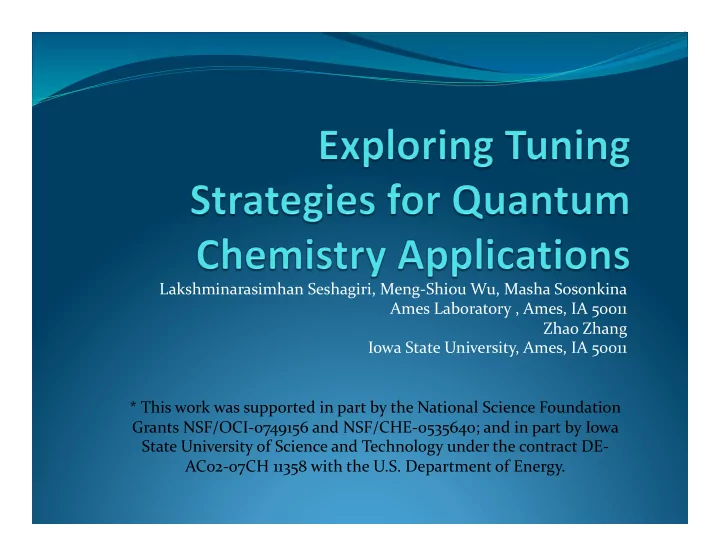

Lakshminarasimhan Seshagiri, Meng‐Shiou Wu, Masha Sosonkina Ames Laboratory , Ames, IA 50011 Zhao Zhang Iowa State University, Ames, IA 50011 * This work was supported in part by the National Science Foundation Grants NSF/OCI‐0749156 and NSF/CHE‐0535640; and in part by Iowa State University of Science and Technology under the contract DE‐ AC02‐07CH 11358 with the U.S. Department of Energy.
Outline Motivation Introduction to GAMESS and existing adaptation structure using NICAN Methodology Performance Results Tuning Strategy Conclusions and Future Work
Motivation Computational Chemistry application performance depends on Input parameter combinations Underlying hardware configuration Adaptation to varying system conditions is required for consistently good performance. Application performance analysis required to understand effect of input parameters and system configuration on application performance. Analysis helps to design a tuning strategy for such applications.
Introduction Ab initio Quantum Chemistry Applications Studies properties of molecules (energy, geometry etc) Based on Schrödinger equation. Schrödinger equation can be solved (only) approximately semi empirical ‐ uses experimental measurements ab‐initio ‐ collection of mathematical methods Other scientific applications based on ab‐initio methods includes GAMESS, NWCHEM, MOLPRO
Introduction GAMESS General Atomic and Molecular Electronic Structure System is generic ab initio quantum chemistry calculation package calculates wide range of Hartree‐Fock (HF) wave functions (RHF, ROHF, and UHF) uses Self‐Consistent‐Field (SCF) method (with direct and conventional implementations) direct ‐ recomputes integrals on‐the‐fly for each iteration (memory and CPU intensive) conventional ‐ computes integrals once, stores on disk, and reuses for each iteration (I/O intensive)
Introduction Computation Process The initial stage The iterative stage The post‐HF stage One electron Coupled integral computation Form the Fock matrix Cluster as the core (one‐electron) Two electron integrals + the density integral computation matrix * the two‐electron MP2/MPn integrals Form the Initial Density matrix CI Diagonalize Fock matrix … Small, can be stored on Form new density matrix, disk or in memory. Check convergence Correct errors ( improve accuracy) in HF matrix Can be huge, affected by the size of basis set The two electron integrals are stored on disk (conventional) or computed on the fly (direct).
Introduction Two patterns of execution ( direct and conventional) favor different computational resources Need for efficient execution of GAMESS jobs and analysis of system resources: memory, I/O, architecture (SMP) Incorporating self‐scheduling into GAMESS or manual analysis by the user is infeasible Modern schedulers (PBS, LoadLeveler, LSF, etc..) incapable to “peek” into application’s execution Integrate GAMESS with application level middleware ( NICAN)
Introduction NICAN Network Information Conveyer and Application Notification Decouples process of analyzing system information from application execution Enables adaptation functionality for distributed applications Requires minor changes to adapting application Lightweight module‐driven middleware CPULoad, Latency, PacketProbe, etc.
Introduction NICAN
Introduction GAMESS‐NICAN Integration model
Introduction Dynamic Algorithm Selection Assumes real‐world scenario: GAMESS calculations are run in multi‐user/application environment Examples: Disk I/O congestion may appear when an external application runs on the same SMP node as GAMESS Highlight of decision making process Collect data Compare current iteration performance to past and make decision Switch algorithm
Introduction Adaptation Process Very few lines of GAMESS code change Low overhead by Manager
Reason to modify this adaptation scheme Algorithm effective in improving performance of GAMESS Iteration time data collected on‐the‐fly Need to include other parameters in the adaptation algorithm in order to reflect various scenarios that affect the application Hence collect application performance data on different architectures and then augment the existing adaptation scheme.
Methodology Application Experiment Trial Experimental runs with different GAMESS Computations system settings Experiment set 1 Energy Metadata (Platform 1, CPU, cache.., etc.) Metadata (conv‐SCF, .., etc) Experiment set 2 Application characteristics Metadata (Platform 2, CPU, cache.., etc.) System characteristics … Energy Experiment set 1 Metadata (Platform 1, CPU, cache.., etc.) Metadata (directSCF, .., etc) Experiment set 2 Metadata (Platform 2, CPU, cache.., etc.) … …
Methodology Application Workload Choose application workload to include different sets of molecules. Molecules need to represent real world usage. Two different sets of molecules chosen for testing First set (Hiro molecules) of 7 molecules of varying molecular structure Second set of 6 benzene molecules with very similar structure Molecules represent fundamental aromatic systems, models used for DNA stacking and protein folding and are part of carbon nano materials.
Methodology Architectures Choose different architectures on which the application can be tested. Franklin : CRAY‐XT cluster provided by NERSC Sun T2 Niagara Machine: Single chip 8 cores. Each core capable of running 8 threads simultaneously. Ames Lab SMP cluster “Borges" : 4 nodes. Each node contains two dual‐core 2.0GHZ Xeon “Woodcrest" CPUs. Gigabit Ethernet interconnect between nodes.
Methodology Performance Data and Tools Decide performance data to be collected Overall time spent in Computation Overall time spent in IO Overall time spent in Communication Choose appropriate profiling tools to get the performance data. TAU (Tuning and Analysis Utility)
Performance Analysis Performance results shown only for np‐dimer and C60 molecules. Results collected for input combinations of MP0, MP2, Direct and Conventional.
Performance Analysis np‐dimer Borges '(/0"#$1%+,'2$'*",'.3%4,15$6% '(/0"#$1%2"1$3*%4,15$6% '#!!" %#!!" +,&'-."/0&1" ,-()./"01(2" '!!!" %!!!" 23"/0&1" 34"01(2" +,&&"/0&1" &!!" ,-(("01(2" $#!!" !"#$% !"#$% %!!" $!!!" $!!" #!!" #!!" !" !" ()!*'+#" ()!*#+'" ()!*'+$" ()!*#+#" ()!*$+'" ()!*#+$" ()!*$+#" ()#*'+#" ()#*#+'" ()#*'+$" ()#*#+#" ()#*#+$" &'!($)%" &'!(%)$" &'!($)*" &'!(%)%" &'!(*)$" &'!(%)*" &'!(*)%" &'%($)%" &'%(%)$" &'%($)*" &'%(%)%" &'%(%)*" &'()*%+,#-"'.*",'% &'()*%+,#-"'.*",'%
Recommend
More recommend